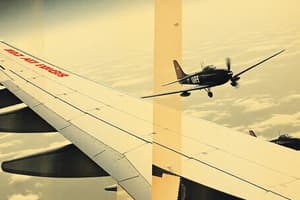Podcast
Questions and Answers
Which control is considered the primary control for rpm in piston helicopters?
Which control is considered the primary control for rpm in piston helicopters?
- Collective pitch
- Throttle (correct)
- Cyclic pitch
- Tachometer
What is the purpose of the cyclic pitch control in a helicopter?
What is the purpose of the cyclic pitch control in a helicopter?
- Manage the manifold pressure
- Tilt the tip-path plane in the desired horizontal direction (correct)
- Control the fuel mixture
- Adjust the collective pitch
In what direction does the rotor disc tilt if the cyclic pitch control is moved aft?
In what direction does the rotor disc tilt if the cyclic pitch control is moved aft?
- Forward
- Sideways
- Aft (correct)
- Upwards
Which control influences manifold pressure in piston helicopters?
Which control influences manifold pressure in piston helicopters?
What should be avoided when making adjustments to aircraft control?
What should be avoided when making adjustments to aircraft control?
Which control allows the pilot to fly the helicopter in any horizontal direction?
Which control allows the pilot to fly the helicopter in any horizontal direction?
What does the cyclic pitch control change?
What does the cyclic pitch control change?
What controls the attitude and airspeed of a helicopter?
What controls the attitude and airspeed of a helicopter?
What does the rotor disc tilt in the same direction as?
What does the rotor disc tilt in the same direction as?
What should be analyzed to determine which control to use in helicopters?
What should be analyzed to determine which control to use in helicopters?
What controls are considered secondary controls of each other's function in piston helicopters?
What controls are considered secondary controls of each other's function in piston helicopters?
Where is the cyclic pitch control typically mounted in a helicopter?
Where is the cyclic pitch control typically mounted in a helicopter?
Flashcards are hidden until you start studying
Study Notes
Introduction to Aerodynamics, Aircraft Assembly, & Rigging
- Three essential topics in aircraft manufacture, operation, and repair are aerodynamics, aircraft assembly, and rigging.
- Basic understanding of aerodynamics is crucial for comprehending aircraft flight preparation.
Basic Aerodynamics
- Aerodynamics studies the dynamics of gases and the interaction between moving objects and the atmosphere.
- Unlike water, air is compressible, affecting how objects move through it.
- Terms like rudder, hull, and keel beam originate from nautical terminology, illustrating the connection to aviation.
- Knowledge of aerodynamics is not required to the same extent for A&P mechanics as it is for aeronautical engineers.
Density of Gases
- Density is directly proportional to pressure and inversely proportional to temperature.
- High altitude air is less dense than low altitude air, affecting aircraft performance.
- Aircraft can achieve higher speeds in low-density air due to reduced resistance.
Humidity
- Humidity refers to the amount of water vapor in the air, which changes with temperature.
- Absolute humidity measures the weight of water vapor per unit volume; relative humidity compares actual moisture to potential saturation.
- Air density decreases as humidity increases, making conditions on damp days less favorable than on dry days.
Wing Flaps and Lift
- Permanent slots can be integrated into wing designs to improve lift at low airspeeds by increasing airflow.
- Slats are movable surfaces at the wing's leading edge that create slots to enhance lift during crucial flight phases.
- Lift-decreasing devices include speed brakes (spoilers), which can be used for braking or lateral control.
Types of Speed Brakes
- Ground spoilers assist braking after landing; flight spoilers enhance lateral control during flight.
- In some aircraft, aileron movement is coordinated with spoiler operation to manage lift effectively.
Helicopter Lift Dynamics
- Unequal lift on helicopter rotor blades occurs due to varying relative wind speeds on the advancing and retreating sides.
- The advancing blade experiences increased relative airflow, creating more lift than the retreating blade.
- Automatic flapping and feathering of blades in articulated systems work to equalize lift across the rotor disc, preventing roll.
Blade Tip Speed
- Blade tip speed can vary significantly, affecting performance; for example, a helicopter may reach speeds of about 300 knots with appropriate forward flight.
Studying That Suits You
Use AI to generate personalized quizzes and flashcards to suit your learning preferences.




